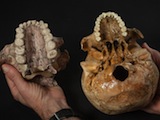séminaire – vendredi 8 février 2019
 Evolution’s bite: a story about teeth, diet, and human origins
Evolution’s bite: a story about teeth, diet, and human origins
Peter Ungar, Chair of Anthropology, University of Arkansas
vendredi 8 février 2019, à 11 heures, amphithéâtre Monge
Fossil teeth can help us understand life in the past. They are the only parts of the digestive system to preserve over deep time, and so allow us to reconstruct diets of extinct primates and our distant ancestors. This presentation will summarise the two basic categories of evidence: adaptive lines (e.g., tooth size, shape and structure), and traces of actual feeding behavior (e.g., isotopic composition of enamel and microscopic use wear). Adaptive evidence and foodprints teach us something about what our ancestors were capable of eating and what specific individuals in the past actually ate on a daily basis. Combining the two lines of evidence provides the clearest picture we have of food choice in the past, and how this relates to our evolution. The focus of this talk will be on how we characterise and compare tooth shape and wear, with special consideration of how teeth work and how they are used by living primates. Examples of what teeth have taught us about the diets of our distant ancestors will also be given.
- kc_data:
- a:8:{i:0;s:0:"";s:4:"mode";s:0:"";s:3:"css";s:0:"";s:9:"max_width";s:0:"";s:7:"classes";s:0:"";s:9:"thumbnail";s:0:"";s:9:"collapsed";s:0:"";s:9:"optimized";s:0:"";}
- kc_raw_content:
 Evolution’s bite: a story about teeth, diet, and human origins
Evolution’s bite: a story about teeth, diet, and human originsPeter Ungar, Chair of Anthropology, University of Arkansas
vendredi 8 février 2019, à 11 heures, amphithéâtre Monge
Fossil teeth can help us understand life in the past. They are the only parts of the digestive system to preserve over deep time, and so allow us to reconstruct diets of extinct primates and our distant ancestors. This presentation will summarise the two basic categories of evidence: adaptive lines (e.g., tooth size, shape and structure), and traces of actual feeding behavior (e.g., isotopic composition of enamel and microscopic use wear). Adaptive evidence and foodprints teach us something about what our ancestors were capable of eating and what specific individuals in the past actually ate on a daily basis. Combining the two lines of evidence provides the clearest picture we have of food choice in the past, and how this relates to our evolution. The focus of this talk will be on how we characterise and compare tooth shape and wear, with special consideration of how teeth work and how they are used by living primates. Examples of what teeth have taught us about the diets of our distant ancestors will also be given.
- titre:
- Evolution’s bite: a story about teeth, diet, and human origins
- intervenant:
- Peter Ungar
- date:
- vendredi 8 février 2019
- extrait:
- lien_externe:
